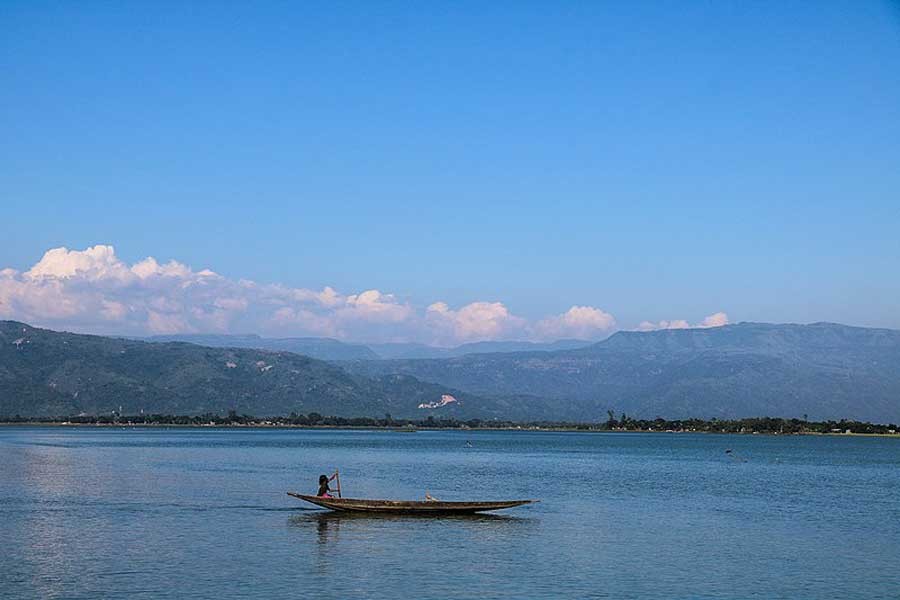Sunamganj, a district located in far north-eastern region of the country, is a culmination of vast geographic diversity. The district sits along the base of Meghalaya hills and itself embodies some of the largest Haors of the country. Such geographic terrain makes the land submerged under water during the most of the part of the year. While, the rest of the time, vast Haors become alluvial and fertile fields for promising agriculture. Such mode of nature had formidable impact on people's lifestyle, culture, modes of communication and most importantly education.
People here reside in clusters of families in tiny island like highlands located sparsely in big Haors. So during monsoon and flood, they are detached from larger community, leaving the Boat as their only mode of communication. This is the period of the year, when they find time lapse to be very slow in absence of some productive work. At the onset of autumn, while water begins receding from this locality and it is only then they can turn up the heat and start moving towards the fields to produce for the rest of the year.
Such bimodal transformation of livelihood makes life less competitive and detached from the fast moving growth of the entire nation. The people of Haor find a little interest in radically changing their life by the utilization of knowledge, information and technology. So, education is greeted with tertiary importance by this people, which is the biggest challenge for implementation of national education policy in Haor area and to bring about revolutionary changes to the lives of the Haor citizens.
Decades of post-liberation war efforts to bring quality education in Haor areas were unplanned, discrete and taken from top-down approach. Education policy taken to be implanted generically for the entire country used to perform very poor in the Haor area because of its unique and diverse geography and people's perception. The rate of literacy along with the dropout rate were one of the country's lowest. Percentage of students reaching higher secondary education was less than 40% while that of reaching under-graduation level was even lower .Percentage of girls among total students never reflected the country average.
With such devastating picture in this sector, the government started to assume the real differences in the perspective of Sunamganj. The dynamic role played by central and top-tier of the government and veteran bureaucrats of the country started a mission to achieve millennium development goals. With a quest to achieve the quality of education and adaptation of policy on the need basis, the top-down policy formulation was discarded and pragmatic measures were taken to form the bottom-up approach of education policy. All this effort resulted in policies like "National Education Policy 2010" as well as achievement of millennium development goals and many notable awards by our HPM on different occasions.
Diving deep into the fact, primary schools have been established at each locality, to lessen the harassment of communication during monsoon. Attendance of teachers has been ensured with recruitment and appointment of thousands of teachers in the schools. Books now reach the students, no matter how remote they are, on the very first day of the year. Boats have been given to schools of remote locality so that students can commute easily during adverse weather. In Sunamganj alone, 1437 pre-nursery class rooms have been decorated like play house, so that, every child coming to schools find it more attractive than home. To create sense of timeliness among children, 4383 clocks have been set up in class rooms. 1860 New National Flag with 1572 flag stands have been hoisted in schools to commemorate patriotism in infant hearts. Bangabandhu Corner and Muktijuddho Libraries have been set up at 1460 educational institutions. Students now learn about the history, culture and struggle of our nation in a proper and meticulous way. To teach them about cleanliness 4933 pedal waste bins have been given in different institutions. They are encouraged to take part in different extra-curricular activities regularly to make them sporty and active.
The advancement of the world has been brought to the students via digital mediums of education. Sheikh Russel labs of ICT have been set up in different schools. The students are shown different audio-visual aids to facilitate their learning. Web-based digital contents are provided from the directorate of primary education regularly.
Not only the students, now the teachers themselves get a better and regular training to understand and assess the needs of their students. Every five schools have been put under monitoring of a government official, to supervise activities and arranging solution to any crisis.
Different stipends, scholarships and financial aids given to people have been introduced in digital financing mediums. Now guardians receive financial aid in mobile banking accounts rather than collecting physically.
The most vital pillar of the current education policy regarding Haor is making of the system more prompt, reactive to change requirements. The teachers, school inspectors, education officers and the local administration do not work in traditional bureaucratic hierarchy anymore. All of them, including the students and their guardians have taken a stakeholder approach enabling them to expand their thinking horizon to multidimensional.
Government's vision to achieve Sustainable Development Goals 2030 has a pillar of Goal 4: Quality Education for all. Likely, our honorable Prime Minister has taken a priority initiative of Education Support Program. All the links of the chain have identified the Quality Education of Haor as one of prime concern areas.
Hopefully, the current spate of activities and initiatives will work in harmony to dramatise the education stream of Haor area and enlighten the children to develop their future.
The writer is Deputy Commissioner and District Magistrate, Sunamganj
[email protected]


